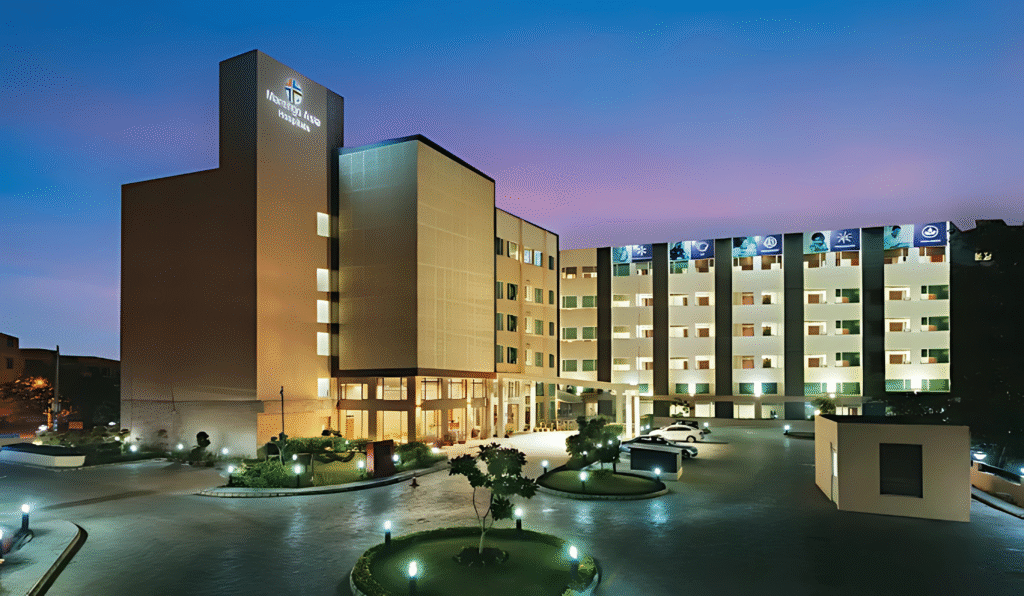Kidney Stone Treatment Cost in India

What is Kidney Stone ?
A kidney stone is a hard, crystalline mineral deposit that forms inside the kidneys when substances like calcium, oxalate, and uric acid become too concentrated in the urine. These substances stick together to form small, pebble-like stones that can vary in size—from as tiny as a grain of sand to as large as a golf ball. While some stones remain in the kidney without causing symptoms, others travel through the urinary tract and can cause intense pain, especially when they obstruct the ureter (the tube connecting the kidney to the bladder).
Kidney stones are a common urological condition and can affect people of all ages, though they are more frequently seen in adults between 30–60 years. They can be a one-time occurrence or recur if the underlying causes are not addressed. Timely detection and treatment are essential to prevent complications such as infection, kidney damage, or urinary obstruction.
How Does Kidney Stone Develop?
Kidney stones develop when the balance of water, minerals, and salts in the urine becomes disrupted. Under normal conditions, urine contains chemicals that prevent these substances from sticking together. However, when there is an imbalance—due to dehydration, dietary factors, or metabolic disorders—these minerals and salts can crystallize and begin to clump together, forming stones.
Initially, the crystals may be very small and pass through the urinary tract unnoticed. But over time, especially if the conditions persist, they can grow larger and form solid masses. These stones may stay within the kidney or move down into the ureter. When a stone gets lodged in the ureter, it blocks the flow of urine, causing the kidney to swell and trigger severe, sharp pain (known as renal colic). This is often accompanied by nausea, vomiting, or blood in the urine.
Several factors can accelerate stone formation, including not drinking enough fluids, consuming high levels of oxalate-rich or sodium-rich foods, obesity, certain medications, and underlying health conditions like hyperparathyroidism or chronic urinary tract infections.
Kidney stone formation is often a slow process, and in many cases, patients may not notice symptoms until the stone has reached a problematic size or location. Regular hydration and dietary management play key roles in preventing their development.
Causes and Risk Factors of Kidney Stones
Kidney stones form due to a combination of metabolic imbalances and lifestyle choices that lead to an accumulation of certain substances in the urine. These substances—such as calcium, oxalate, uric acid, and cystine—can crystallize when present in high concentrations, especially when urine volume is low. Understanding both the primary causes and risk factors is crucial for preventing recurrence and managing this painful condition.
Primary Causes of Kidney Stones
Dehydration: Inadequate fluid intake reduces urine volume, increasing the concentration of stone-forming minerals.
High Oxalate or Sodium Diet: Consuming large quantities of oxalate-rich foods (like spinach, nuts) or excess salt increases calcium and oxalate levels in the urine.
Excess Calcium or Uric Acid: Elevated calcium or uric acid levels due to dietary intake or metabolic issues can promote stone formation.
Chronic Urinary Tract Infections (UTIs): Certain bacteria in recurring UTIs can produce ammonia, increasing the likelihood of struvite stones.
Genetic or Metabolic Disorders: Conditions like hyperparathyroidism or renal tubular acidosis increase the risk of specific types of stones.
Risk Factors Contributing to Kidney Stones
Family History: A genetic predisposition may make some individuals more likely to form stones.
Obesity: Higher body mass index (BMI) affects urine composition and increases the excretion of stone-forming substances.
Sedentary Lifestyle: Limited physical activity can slow down metabolism and reduce bone strength, leading to calcium release into the bloodstream and urine.
Certain Medications & Supplements: Long-term use of diuretics, calcium-based antacids, or high-dose vitamin D can increase stone risk.
Gastrointestinal Conditions: Diseases like Crohn’s or chronic diarrhea affect calcium and water absorption, promoting stone formation.
Symptoms of Kidney Stones
Kidney stones can vary in size and type, and so can their symptoms. While small stones may pass without causing noticeable issues, larger stones can block the urinary tract, resulting in intense pain and other distressing symptoms. The severity and location of the stone influence how symptoms present, and early recognition is key to prompt and effective treatment.
Common Symptoms of Kidney Stones
Severe Pain in the Back or Side: Often described as sharp, cramping pain in the lower back or side, usually just below the ribs. This pain can radiate to the lower abdomen or groin as the stone moves.
Pain During Urination: As the stone travels through the ureter and irritates the urinary tract lining, it can cause burning sensations or intense discomfort while urinating.
Blood in Urine (Hematuria): The presence of stones can cause tiny abrasions in the urinary tract, resulting in pink, red, or brown-colored urine.
Frequent Urge to Urinate: Especially when the stone is near the bladder, it can lead to an urgent or persistent need to urinate.
Cloudy or Foul-Smelling Urine: A sign of infection or the presence of excess crystals in the urine.
Nausea and Vomiting: Pain from kidney stones can activate nearby nerves in the digestive tract, leading to gastrointestinal symptoms.
Fever and Chills (if infection is present): A possible sign of a urinary tract infection or kidney infection that requires immediate medical attention.
Types of Kidney Stones
Kidney stones are classified based on the substances that form them. Identifying the type of kidney stone is essential because it influences treatment and helps prevent recurrence. Each type develops due to different metabolic or dietary imbalances, and some are more common than others.
The most common type of kidney stone, formed when calcium combines with oxalate in the urine. Low fluid intake, high-oxalate foods (like spinach, nuts, or chocolate), and certain metabolic conditions can increase the risk.
Common in: People with diets high in protein and sodium, or those with inflammatory bowel diseases.
Prevention: Staying hydrated and reducing oxalate-rich foods and sodium.
These stones form when urine is consistently too acidic, often due to high-purine diets (red meat, organ meats, shellfish) or conditions like gout.
Common in: Individuals with high meat consumption or those with chronic diarrhea or diabetes.
Prevention: Alkalizing the urine with medications and a low-purine diet.
These are infection-related stones, often large and fast-growing. They form in response to urinary tract infections caused by bacteria that make the urine more alkaline.
Common in: Women with recurrent UTIs.
Prevention: Managing infections early and maintaining urinary tract health.
A rare type, caused by a genetic disorder called cystinuria, which leads to excess cystine (an amino acid) in the urine.
Common in: People with a family history of cystinuria.
Prevention: High fluid intake and medications that reduce cystine concentration in urine.
Other stones can be made of xanthine or drug-related compounds due to specific metabolic disorders or medications. These are extremely rare and usually linked to underlying medical conditions.
Which Type of Kidney Stone is the Most Dangerous?
Among all types, struvite stones are often considered the most dangerous. This is because they grow rapidly, can become very large (sometimes forming staghorn stones), and are usually associated with chronic urinary tract infections. If not treated promptly, struvite stones can lead to kidney damage, obstruction, or life-threatening infections such as sepsis.
Why Choose India for Treatment of Kidney Stone
India has emerged as a global hub for high-quality and affordable kidney stone treatment. With state-of-the-art technology, top urologists, and a strong focus on patient-centered care, it offers comprehensive solutions ranging from non-invasive to advanced surgical interventions.
Indian hospitals offer a full spectrum of minimally invasive procedures like RIRS (Retrograde Intrarenal Surgery), PCNL (Percutaneous Nephrolithotomy), and laser lithotripsy. These reduce recovery time, minimize pain, and improve treatment outcomes significantly.
Leading urologists in India not only treat stones but also focus on preventing recurrence through detailed metabolic evaluations, dietary counseling, and long-term care plans tailored to the patient’s lifestyle and health profile.
Given the acute pain kidney stones can cause, Indian hospitals provide round-the-clock emergency services, quick diagnostics, and streamlined admissions. Post-operative care is equally robust, with dedicated urology recovery units.
Indian urologists are globally trained and experienced in handling complex urological cases. Many hold certifications and fellowships from renowned institutions abroad and are adept with the latest technology and techniques in urological surgery.
Treatment for kidney stones in India is significantly more affordable compared to Western countries, even in premium hospitals. This includes surgery, hospitalization, consultation, and follow-up care, all bundled in transparent, cost-effective packages.
Top hospitals are equipped with modern operating theaters, robotic systems, and diagnostic labs. They also offer dedicated international patient services including visa assistance, language interpreters, airport transfers, and personalized care coordinators throughout the stay.
Different types of Kidney Stone Treatment in India
Prostate cancer treatment depends on factors like cancer stage, patient age, overall health, and the aggressiveness of the tumor. There are multiple treatment options available, ranging from active surveillance for slow-growing tumors to aggressive therapies for advanced cases.
Here’s a detailed breakdown of the different treatments used for prostate cancer:
How It Works:
Doctors may prescribe alpha-blockers to relax the muscles in the ureter, allowing smaller stones to pass more easily. Pain relievers and anti-inflammatory medications are also used to manage discomfort during the passing process.
When It’s Used:
For stones smaller than 5 mm
When stones are expected to pass naturally
As part of a preventive strategy for recurrence
Benefits:
Non-invasive and cost-effective
Reduces pain and inflammation
Can help dissolve certain types of stones like uric acid stones
How It Works:
This technique uses focused sound waves to break larger stones into smaller fragments that can be passed naturally through the urine.
When It’s Used:
Stones between 5 mm and 20 mm
Located in the kidney or upper ureter
When non-surgical intervention is preferred
Benefits:
Non-invasive and painless
Short recovery time
No need for incisions or anesthesia in most cases
How It Works:
Encouraging high fluid intake helps flush out small stones and prevents new ones from forming by diluting substances in the urine that lead to stones.
When It’s Used:
As a preventive measure
For very small stones
As part of long-term kidney stone management
Benefits:
Completely natural approach
Improves kidney function
Essential for preventing recurrence
How It Works:
A thin, flexible tube (stent) is placed in the ureter to allow urine—and small stones—to pass freely from the kidney to the bladder.
When It’s Used:
When a stone causes blockage or swelling
Before or after surgery
In cases with recurrent stones or infection
Benefits:
Prevents kidney damage from obstruction
Reduces pain from urine backup
Supports healing after stone removal procedures
How It Works:
In this surgical technique, a small incision is made in the back to access the kidney directly and remove large or complex stones using a nephroscope.
When It’s Used:
Stones larger than 20 mm
Staghorn or multiple kidney stones
Failed non-invasive treatments
Benefits:
High success rate for large stones
Shorter hospital stay than open surgery
Effective for complex or recurring stones
Different Procedures for Kidney Stone Treatment in India
When medications and non-surgical methods aren’t effective, various procedures are employed to safely remove kidney stones. India offers both traditional and technologically advanced options for optimal outcomes.
How It Works:
High-energy sound waves are targeted at the stone from outside the body, breaking it into small pieces that can be passed naturally through urine.
When It’s Used:
Stones up to 20 mm
Located in the kidney or upper ureter
For patients unable to undergo surgery
Benefits:
Non-invasive
Minimal recovery time
Outpatient procedure in most cases
How It Works:
A thin scope is inserted through the urethra and bladder to reach the ureter or kidney. The stone is either removed directly or broken into smaller pieces with a laser.
When It’s Used:
Stones in the lower urinary tract
Stones resistant to ESWL
When visual assessment is needed
Benefits:
No incisions required
High precision and accuracy
Can remove or fragment even hard stones
How It Works:
A laser fiber passed through a ureteroscope targets and vaporizes the stone into fine dust or small fragments for natural expulsion.
When It’s Used:
Medium to large stones
Hard stones like calcium oxalate
In combination with ureteroscopy
Benefits:
Minimally invasive
High success rate
Precise stone fragmentation
How It Works:
Similar to PCNL, this involves a small incision to access the kidney and surgically remove very large or irregular stones using specialized instruments.
When It’s Used:
Stones larger than 2 cm
Complex or irregularly shaped stones
When other treatments fail
Benefits:
Effective for large stones
Minimizes need for multiple sessions
Can address both renal and ureteral stones
How It Works:
A small wire basket is passed through an endoscope to physically capture and remove small stones during a ureteroscopic procedure.
When It’s Used:
Small stones located in the ureter or bladder
As part of ureteroscopy or laser lithotripsy
For stones causing blockages
Benefits:
Immediate stone removal
Minimally invasive
Fast recovery and minimal discomfort
Other Advanced Procedures for Kidney Stone Treatment in India
India offers several advanced and innovative approaches for diagnosing and managing complex or recurrent kidney stones. These methods are especially beneficial for patients with large, hard-to-reach stones or those with unsuccessful results with traditional treatments.
- A less invasive variant of traditional PCNL that uses smaller instruments and access tracts.
- Ideal for medium-sized stones with less tissue trauma and quicker recovery.
- Reduces bleeding risks and post-operative discomfort.
- Uses ultra-miniature instruments for removing small stones with minimal invasion.
- Requires a tiny incision and is performed under imaging guidance.
- Offers faster recovery and lower complication rates.
- A flexible ureteroscope is passed through the urinary tract to reach and treat kidney stones.
- Especially effective for stones in difficult locations like the lower pole.
- Laser energy is used to break stones without any incisions.
- Utilizes robotic systems for high-precision stone removal in complex cases.
- Provides enhanced visualization and dexterity in minimally invasive procedures.
- Useful in anatomically challenging situations or repeat surgeries.
- Comprehensive metabolic evaluation to identify the cause of recurrent stone formation.
- Includes dietary counselling, targeted medical therapy, and long-term follow-up plans.
- Personalized management plans reduce recurrence risk significantly.
Cost of Kidney Stone Treatment in India
India is a popular destination for kidney stone treatment due to its advanced medical facilities, expert urologists, and significantly lower treatment costs compared to Western countries. Whether it’s non-surgical therapy or minimally invasive procedures, patients receive world-class care at affordable rates, making India ideal for both domestic and international patients.
✔ Factors Affecting the Cost of Kidney Stone Treatment in India
The total cost depends on several factors, including:
1. Type and Size of Kidney Stones
Small stones often pass with the help of medications and hydration therapy, incurring minimal cost.
Larger stones or multiple stones may require surgical or non-surgical intervention like ESWL, PCNL, or URS.
2. Choice of Treatment
Non-surgical methods (medications, dietary changes) are the most cost-effective.
Minimally invasive or surgical procedures like laser lithotripsy, ureteroscopy (URS), and percutaneous nephrolithotomy (PCNL) cost more due to operating room charges, anesthesia, and specialist fees.
3. Hospital & Location
Metro cities like Delhi, Mumbai, Bengaluru, and Chennai may charge slightly more than tier-2 cities.
Costs also vary between public, private, and super-specialty hospitals.
4. Additional Expenses
Pre-operative tests: Imaging (CT scan, ultrasound), urine and blood tests.
Hospital stay: Usually 1–3 days for minor procedures and up to 5–7 days for complex cases.
Follow-up care & medications: Pain relief, antibiotics, and dietary supplements post-surgery.
✔ Estimated Cost of Kidney Stone Treatment in India
India offers a range of kidney stone removal options, each with its own pricing depending on the technique and complexity.
| Type of Treatment/Procedure | Estimated Cost (INR) | Estimated Cost (USD) |
|---|---|---|
| Medication & Hydration Therapy | ₹5,000 – ₹15,000 | $60 – $180 |
| Extracorporeal Shock Wave Lithotripsy (ESWL) | ₹30,000 – ₹70,000 | $360 – $850 |
| Ureteroscopy (URS) | ₹40,000 – ₹90,000 | $480 – $1,080 |
| Percutaneous Nephrolithotomy (PCNL) | ₹70,000 – ₹1,50,000 | $850 – $1,800 |
| Laser Lithotripsy | ₹60,000 – ₹1,20,000 | $720 – $1,440 |
✔ Additional Costs
| Component | Estimated Cost (INR) | Estimated Cost (USD) |
|---|---|---|
| Pre-operative Tests | ₹5,000 – ₹10,000 | $60 – $120 |
| Hospital Stay (1–3 days) | ₹10,000 – ₹30,000 | $120 – $360 |
| Post-treatment Medications | ₹2,000 – ₹5,000 | $25 – $60 |
| Follow-Up Consultations | ₹1,000 – ₹2,500 per visit | $12 – $30 per visit |
Note:
Costs can vary based on hospital location, patient’s overall health, and type of kidney stone.
International patients may incur additional expenses related to visa processing, hotel stays, and translation services.
Best Doctors for Kidney Stone Treatment in India
Best Hospitals for Kidney Stone Treatment in India
Med Travel India Offerings
How does Med Travel India help you?
Services offered by Med Travel India

Seamless Planning for Your Medical Journey
Before you even arrive, we take care of all the groundwork. From connecting you with top specialists to ensuring all necessary medical evaluations are completed, we make your journey stress-free. Our goal is to provide clarity and comfort before your treatment begins.
- Free Medical Consultation
- Personalized Treatment Plan
- Estimated Cost & Duration
- Visa Assistanc
- Second Opinion Service
- Pre-Arrival Coordination
Worry-Free Travel & Comfortable Stay
We ensure that your journey to India is as smooth as possible. From booking your flights to arranging a comfortable stay near your hospital, we handle everything so you can focus on your health.
- Flight Booking Assistance
- Accommodation Booking
- Airport Pickup & Drop
- Language Interpretation Services
- Local Transport Arrangements
- Currency Exchange Support


World-Class Medical Care, Personalized for You
We ensure that your medical treatment is well-organized and efficient. Our team works closely with hospitals to facilitate smooth admissions, consultations, and procedures, ensuring you receive top-quality healthcare.
- Priority Appointment Scheduling
- Direct Hospital Admission
- Specialist Doctor Assignment
- Pharmacy & Medical Supplies
- Hospital Admission & Discharge Support
- 24/7 Customer Assistance
Continued Support for a Speedy Recovery
Your health journey doesn’t end after treatment. We provide post-procedure assistance to ensure a smooth recovery, whether you stay in India for rehabilitation or return home.
- Post-Surgical Care Coordination
- Rehabilitation & Physiotherapy
- Virtual Doctor Consultations
- Diet & Lifestyle Guidance
- Extended Stay Arrangements
- Post-treatment Medical Supplies


Beyond Healthcare, A Comfortable Experience
We offer additional services to make your stay in India comfortable and enriching, ensuring that your well-being is cared for beyond the hospital.
- Medical Insurance Settlement Help
- SIm Card Assistance
- Customized Sightseeing Tours
- Medical Document Assistance
- Personalized Assistance for Family Members
- Concierge Services








































